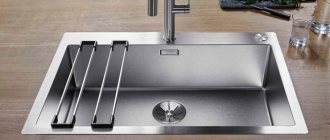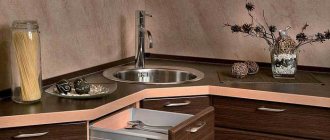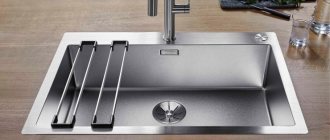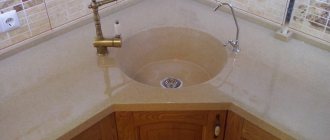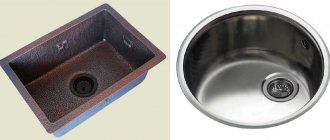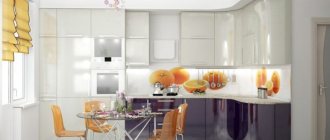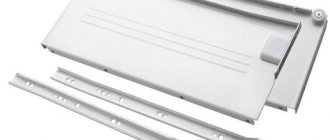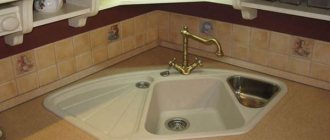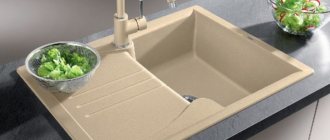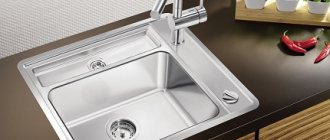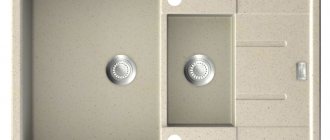Owners of small kitchens constantly have to think about how to make the space more practical, comfortable and functional. One popular solution is to place the kitchen sink in a corner.
But choosing a corner sink for the kitchen is a difficult task and must be done with special care: it’s easy to make a mistake with the dimensions by a couple of centimeters and, as a result, lose a lot of time, effort and money. We will tell you how to choose this plumbing element correctly, quickly and without problems.
Advantages and disadvantages
A corner sink can be called an excellent solution for a small kitchen, for example, in a Khrushchev-era building. It takes up very little space, but is very functional. Of course, it is most often found in U- and L-shaped kitchen layouts. Let us list the main advantages and disadvantages of such products.
Positive features include:
- saving space by using a corner. This means that the rest of the tabletop can be turned into a work area;
- a wide variety of models of corner sinks, due to which such an idea can be implemented in any kitchen;
- increased comfort, because thanks to the sink in the corner of the kitchen, an excellent working triangle is formed, thanks to which the housewife can avoid wasting time on unnecessary movements around the room;
- Corner sink cabinets usually have a lot of space for storing kitchen utensils. The main thing is to arrange it correctly.
But corner sink models also have disadvantages:
- if the size or shape of the sink is incorrectly calculated, a dead zone is formed behind it, which is inconvenient to use;
- It’s also not always convenient to use adjacent cabinets;
- it is difficult to keep a distant corner clean;
- bowls are often smaller than in standard models;
- such products can be difficult to repair, since kitchen corner cabinets have a small door with a relatively large internal volume;
- for the previous reason, installing water filters will also be difficult.
A new kitchen sink should:
- have high functionality;
- serve for a long time and be resistant to various influences;
- be roomy;
- match with the interior;
- be convenient to use.
These factors should be taken into account when choosing a corner sink for the kitchen.
Kitchen sink with cabinet: types and their characteristics
Choosing furniture for a corner sink requires understanding the compatibility of the elements of the set with each other. As a rule, plumbing fixtures, as well as furniture for them, are selected taking into account the interior of the kitchen. In this case, you should take into account the color and design of the kitchen corner set. Sometimes the choice of cabinet depends solely on the bowl itself.
It is worth noting right away that modular kitchens do not always represent cabinets corresponding to other elements of furniture. In the kitchen, all individual components of the set must, in one way or another, have maximum functionality. Cabinets are no exception. A competent choice of this furniture unit allows you not only to place a trash can and various cleaning products under the sink, but also to integrate appliances into this space. Placing the dishwasher under the sink is a fairly common solution.
Straight cabinets for sinks are most often equipped with two doors and are more functional
All cabinets are classified into two groups depending on the design features. Each type has its own advantages and disadvantages. There are the following options for kitchen cabinets:
- straight;
- with a beveled corner.
Models that fall into the straight category most often include two doors. They can also have one folding door. In some cases, they are made in the form of a double structure, but this version of the cabinets is much less common. If desired, you can purchase a cabinet under the sink, which has drawers used for storing various kitchen utensils.
A cabinet with a beveled corner is a less popular solution. The thing is that its installation requires compatibility with a corner sink, and not all models are suitable for such a cabinet.
Helpful information! Experts do not recommend buying a beveled model if the sink is large. This design prevents free access to the far corner.
In order to free up space in the kitchen, you can arrange a corner work triangle, the center of which will be the kitchen sink with cabinet
Corner sink with cabinet for the kitchen: dimensions of designs and features of their choice
Before purchasing a kitchen sink, you need to decide on its optimal dimensions. To do this, use a tape measure to measure the free space in the corner of the room.
The single version of the design is most widely used in the domestic market. This is due to the fact that such sinks take up much less space, which is an advantage for standard kitchen spaces that do not have a large amount of free space. A double corner kitchen sink, among other things, is more expensive.
Most often, corner cabinets are selected depending on the size of the sink itself. This is very important, since devices that are incompatible with each other cannot be installed. The size of the corner cabinet (classic) is 60 cm. This indicator corresponds to the width of the furniture. These dimensions are quite enough to hide communications under the sink, as well as to place household chemicals and a trash can.
If the width of the sink is 50 cm, then the best option in this case is to choose a cabinet that has the shape of the Latin letter “L”. This solution allows you to save usable space in the working area, which is very important.
The depth depends on the type of corner sink (countertop or mortise) and the shape
As for the parameters of sinks and cabinets purchased for spacious kitchen spaces, in this case there are no size restrictions. Corner cabinets for kitchen sinks are also selected according to the material they are made of. They can be made from the following raw materials:
- chipboard;
- MDF;
- natural wood.
Chipboard is the least expensive material available. This option is recommended by experts in order to save money. Corner floor-mounted kitchen cabinets made of MDF are a little more expensive, but they have a higher resistance to moisture. The price of wooden cabinets is the highest, but this is justified by the good quality of such furniture intended for the kitchen area.
Which corner sink to choose?
One of the main characteristics that is responsible for meeting the above requirements is the material of manufacture. There are many of them on the modern market - from cheap to expensive, from the most natural to completely artificial. Each option has specific characteristics, pros and cons, which you must familiarize yourself with before choosing and purchasing a product.
Ceramics
Yes, this option is unexpected for the kitchen - it’s much more common to find it in the bathroom. But, nevertheless, ceramic corner sinks exist, which means you can put such an example in your kitchen.
No matter how strange it may seem, there are not only white ceramic sinks: there are also colored ones and even with a pattern - that is, you can match them to any interior. But most often, due to its elegant appearance, ceramic sinks are used in kitchens with classic-style furniture.
| Advantages | Flaws |
| Resistant to hot water and household chemicals | Has significant weight |
| No scratches | Fragile - will not withstand the fall of the frying pan, cracks and chips may form |
| No complex care required | Complex installation |
| Environmental friendliness | Price |
| No noise from running water |
Fake diamond
This material is increasingly gaining popularity and has already surpassed its natural counterpart. A sink made of artificial stone is also called composite. It looks as close as possible to natural stone, has the same strength, but at the same time is not so difficult to maintain and, simply put, is lighter in weight.
| Advantages | Flaws |
| Easy care, the ability to use even aggressive household chemicals (abrasive products should be avoided) | Prices (a corner sink will cost 10–20 thousand rubles) |
| Resistant to sunlight - the color of the sink will not change | |
| Almost silent - water does not create a booming sound when falling | |
| Not afraid of hot water | |
| Huge variety of shapes, colors and sizes | |
| Long service life without loss of attractiveness |
Stainless steel
From year to year, stainless steel ranks first in the ranking of the most actively sold sink materials. Such specimens are indeed more common than others in our kitchens, they are considered indestructible, and such a miracle is really inexpensive.
Note that the surface of a stainless steel sink can be matte, glossy, or even patterned. Few people know about the last option. Since the appearance of stainless sinks is highly controversial, and there are two camps - “like” and “dislike”, we will not include it in the following table.
| Advantages | Flaws |
| Corrosion resistance | Noise when water falls |
| Budget cost | Small variety of colors |
| Easy to install due to light weight | Accumulation of soap and limescale deposits |
| Large selection of shapes and sizes | Appearance of small scratches |
Corner sink for the kitchen: varieties based on material of manufacture
Corner sinks used for washing dishes are made from different materials. Each of them has its own technical characteristics and, accordingly, pros and cons. The following materials are most often used to make sinks:
- stainless steel;
- ceramics;
- stone (artificial and natural).
Stainless steel. Products made from this material are the most common. This is due to the fact that they are affordable. Corner kitchen sinks made of stainless steel can have a matte texture or a glossy surface. Products of the second type are easier to maintain, which is why many experts recommend purchasing them.
Another advantage of stainless steel sinks is their versatility. They have a simple design and can be combined with any type of kitchen interior. Stainless steel is resistant to corrosion. Among the disadvantages of such sinks, it is worth noting their noise. Corner kitchen sinks made of stainless steel are also easy to install, so installing them yourself will not be difficult.
Metal sinks look especially good in classic and traditional kitchen interiors.
Ceramics. Sinks of this type are distinguished by a presentable appearance. Most often, classic white ceramic products are found, but there are also colored models. The main advantage of such sinks is their resistance to moisture and active chemicals used for washing dishes. The disadvantage of such products is their large mass, which complicates transportation and installation. It is also worth noting that chips may occur on the ceramic surface over time.
Artificial and natural stone. Such models belong to the upper price category. The advantages of these sinks are their elegant appearance and long service life. Corner sinks for kitchens made of artificial stone are resistant to aggressive chemicals and high temperatures. The variety of options for products made from this material is very wide.
Natural stone is more expensive than artificial stone, but is considered a more reliable material. Sinks of this type absorb the noise of water flowing from the tap, which is also a big plus.
Today, kitchen sinks are made from various materials with good quality characteristics.
Requirements for corner sink models
The choice of plumbing fixtures is most often made taking into account the individual characteristics of the kitchen space and the personal taste preferences of the owners. However, there are still several important points that you should pay attention to before purchasing a sink.
Before purchasing a corner kitchen sink, you need to calculate its volume. This indicator is selected depending on the personal needs of the kitchen owners. It is necessary that the sink accommodate a certain amount of dishes used during meals for all family members.
Bowls must have good resistance to high temperatures. Otherwise, the service life of the plumbing equipment is reduced several times. It is also very important that the sink is resistant to mechanical stress (impacts).
Experts advise taking the selection of furniture for a corner sink seriously. Kitchen sink cabinets may vary in size, material and design.
The universal size of bowls for any sinks, including corner ones, is a depth of 16-20 cm
Not only corner models, but also any other sink options must have good resistance to aggressive chemical compounds contained in detergents.
Note! Stainless steel products are best able to withstand temperature changes.
And finally, before purchasing this plumbing fixture, you need to determine in advance the place where it will be located and take the appropriate measurements. Kitchen designs with corner sinks can be studied on the Internet. This will allow you to select the required product.
There are two ways to install this type of kitchen sink – with the help of specialists or on your own. In the second case, it is recommended to study the installation instructions and strictly adhere to the sequence of actions that are described in it.
The guidelines for action when choosing sinks should be the dimensions of the kitchen furniture
Fastening
The second point regarding the sink that you need to decide on is how to attach it. There are four options in total:
- Invoice - the easiest sink to install, and also inexpensive. It is as easy to put on as a hat on your head. The only downside of this type of fastening is that water can get into the end of the “cap” and cause the tabletop to swell if it is located nearby. This option is rarely found for corner sinks.
- Mortise - the most common sink mount. The bottom line is that a special hole is cut out in the countertop into which the sink is inserted and secured in various ways. The complexity of installation depends on the materials - it is much easier to make a hole in an MDF countertop than in a stone one. And it’s easier to work with a stainless steel sink than a composite one. Literally. But such a mount saves space in the kitchen and also fits into any interior.
- Underbench (built-in, recessed) - the most modern method of fastening. The sink is installed under the countertop. Installation is very difficult, so most often a professional is required.
- Integrated - in this situation, there is no concept of “sink” as such, because it, together with the countertop, represents a single whole.
What are the different ways to install corner kitchen sinks?
Modern models of corner sinks are classified according to the installation method. Depending on this criterion, all products of this type are divided into two large groups:
- invoices;
- mortise
Invoices. Sinks belonging to this class have special sides. By means of them, the bowl is fixed to the tabletop. A fairly common option is that the overhead sink contains special “wings”. They are used to store dirty dishes.
Stainless steel is most often used to make such sinks. A kitchen sink with a cabinet has its drawbacks. The main one is the limited selection of products.
Mortise. This type of sink is considered more modern and functional. These types of sinks are mounted directly into the countertop. For this, a niche corresponding to the dimensions of the bowl is prepared in advance.
Sinks come in overhead sinks (they are held in place by protruding sides) and mortise sinks (they are sunk into the countertop)
In this case, the sink can be placed at different levels relative to the plane of the countertop. It can be placed above the tabletop, on the same level with it, and also below the surface. It is worth noting that models made of porcelain stoneware and installed in this way look the most presentable (photos of kitchen sinks allow you to verify this).
The advantage of this installation method is that it saves useful kitchen space. Corner mortise models look very impressive and can be combined with almost any type of kitchen set. Such sinks are much more difficult to install yourself. This is due to the need to ensure reliable waterproofing.
Helpful information! Overhead models are most often sold with a cabinet, while mortise models are purchased separately.
The choice of installation method depends on the design features of the kitchen unit and the personal preferences of the owners of the room. Before starting installation (if you do it yourself), it is recommended to read the instructions.
The sink can be located flush with the countertop or below and above the surface
Form
Once the material and method of attaching the corner sink have been determined, it’s time to choose the shape of the bowl. For a long time in our country, the most common option for placement in a corner was considered to be a round sink, so we will begin our review of various models with it.
- Round . The main advantage of this bowl shape is that it can accommodate a large number of dishes in a relatively small area. It must be admitted that in square and rectangular bowls the corners are not used, and dirt accumulates in them - a round sink does not have this drawback. In addition to excellent functionality, one can highlight the visual appeal of this form. The interior will look original.
- Square . This is a versatile and also roomy option. The advantage is that it can even fit on a non-standard tabletop, for example, a narrow one. In such cases, additional functional elements may appear - wings, boards and other accessories for washing. It will look great in a small kitchen.
- Rectangular . Similar to square ones, but more bulky. Such specimens are chosen to increase the functionality of the sink.
But triangular and oval sink bowls are very rare, but these geometric shapes are often taken as the basis for the entire sink.
Dimensions and shape of sinks
Mostly round, rectangular or square models are installed. Semicircular or oval options are less often chosen.
Let's look at typical models:
- Round ones are the most compact, their diameter varies from 400 to 500 mm;
- Rectangular - suitable for rooms with an elongated shape or when the width of the set is less than the standard 60 cm. Common dimensions: 400x500, 400x800, 550x500, 500x800, 500x1000, 500x1250 mm;
- Square - chosen for arranging small kitchens. The most common sizes: 400x400, 500x500, 600x600 mm.
Number of bowls
At this stage, it’s time to decide whether the sink needs additional bowls or wings.
The simplest model of corner sinks is with one bowl and without wings. It is compact, budget-friendly, but at the same time ergonomic.
Most often, single-bowl sinks are either round or rectangular, which makes them comfortable, spacious and functional even when small in size. If you want to save as much kitchen space as possible, then the best choice is a single-bowl round sink.
Instances with two bowls are also often found among corner sinks. Most often, the bowls themselves are located in one line, but there are also original models where they are located at an angle to the tap. This sink is very practical, but it is rational to use it only in spacious kitchens.
It is worth noting that when purchasing a sink with two or even three bowls, it is worth considering a high-quality faucet, since it must withstand numerous turns.
You need to understand that the bowl itself is more of a reservoir, since it does not move or shift: set it and forget it. But the mixer, in turn, is used very actively - the hose is pulled out, the valves turn, the watering can itself moves. For this reason, it is better to avoid faucets that are too cheap.
Small recommendations:
- for a small corner sink with one bowl - a medium-height mixer without a pull-out spout;
- for two bowls or more - a tall mixer, a side lever for switching water, a retractable hose.
A retractable hose is a great feature to have when you have a large kitchen sink. This makes it easier to rinse all the corners, collect water in the pan, and clean it after cooking.
Sink forms
We will consider only the most famous design solutions.
| Corner sink shape | Brief description of appearance and operational parameters |
Corner with one bowl | Made from sheet stainless steel, there are two wings on the sides of different sizes for kitchen utensils. An individual feature of such sinks is the presence of a second tap for filtered water. |
Stainless steel with two bowls | The bowls come in different sizes, allowing you to wash dishes with minimal water consumption. Glasses are washed in a small bowl after morning tea or coffee, and dishes are washed in large bowls after a family dinner. The length of the mixer spout is selected so that when turned it is enough to fill both bowls with water. |
Corner sink with two bowls made of artificial stone | It is installed in large kitchens, has two full-sized side bowls, and in the center there is a special area for detergents. There is one mixer, installed between the sinks. |
Corner semicircular with two bowls | Made of stainless steel, the unique geometry allows you to make maximum use of the free space of the corner table top. Bowls have different sizes, each used depending on the number of dishes. |
Round ordinary stainless steel | The simplest in terms of manufacturing technology, it belongs to the budget category. Detergents are placed in the corner on a specially made stand. |
Corner with three ceramic bowls | Belongs to the elite category, has three bowls of different sizes for washing. The mixer is installed on a separate platform; additional space is provided for temporary storage of clean dishes. |
As can be seen from the short list, there is plenty to choose from, the main thing is not to make a mistake with the analysis of their actual characteristics.
How to choose the size of a corner sink?
Although we are only talking about the sizes of corner sinks now, this is still a very important point. If you make a mistake at this stage, you can end up with non-functional space, incorrect installation, or simply lose money. Due to the complexity of installation, the dimensions of corner sinks must be approached very carefully.
First, let's define what sink size means. Conventionally, this characteristic can be divided into two more: area - that is, width and length; depth.
The easiest way to determine the depth is - it should be about 16–20 centimeters. If this value is less, then splashes will fly in all directions and spoil the mood of the hostess.
If you follow the rule “the more, the better,” you can get back problems, since you will often have to bend over too much. This is especially true for low countertops below 85 centimeters.
The photo shows an example of a corner sink made of artificial stone with dimensions and available colors.
Now let’s decide on the factors that influence what size corner sink to choose:
- Dimensions of the kitchen unit - it is obvious that the cabinet can and should be larger than the built-in sink, but this does not work in the opposite direction.
- The size of the dishes - if it is customary in the family to eat “a little, but often,” for example, from saucers, then there is no point in a large sink. But if the family is large with multi-liter frying pans and pots, then it’s worth taking a closer look at the volumetric options;
- The presence of wings at the sink and their location . If the owner is right-handed, then the wing should be on the right, and vice versa;
- The sink should not be adjacent to the wall or the base of the countertop, so it is better to make a gap of 5 centimeters;
- Type of shell . The discussion above was about mortise and under-table models. With overheads, everything is simpler - like the cabinet, like the sink.
Each corner sink shape has standard sizes that are most commonly found.
| Square | 50x50 cm, 60x60 cm |
| Rectangular | 55x50 cm, 50x80 cm, 50x100 cm, 50x125 cm |
| Round | Diameter from 45 to 51 cm |
Corner sinks: positive and negative sides
It cannot be said with certainty that corner sinks are appropriate in any kitchen. There are a number of things to consider when choosing a kitchen sink.
Corner sinks have undoubted advantages:
- taking up space in the corner of the kitchen, they free up space on the work surface both on the right and on the left. The length of the edges of the working triangle (refrigerator-stove-sink) becomes optimal, eliminating unnecessary movements;
When placing the sink in a corner, the edges of the working triangle become optimal
- a large corner cabinet, above which the sink is installed, allows you to place a large number of necessary devices and accessories inside: a filtration system for water purification;
- disposer (waste shredder);
- water heater;
- system of containers for waste collection;
- large kitchen utensils, etc.;
The large corner cabinet can accommodate many useful devices, including a kitchen waste collection system
Some significant disadvantages are an obstacle to the use of such sinks:
- corner sinks are quite large, so they are not suitable for kitchen spaces with a small area;
- higher price;
- In the case of a cut-in into a plastic-coated tabletop, there are two joints left through which moisture can penetrate during use and cause swelling of the base. In addition, dirt accumulates at the joints;
When connecting plastic countertops, you get two very noticeable joints
- the cost of a corner element of a kitchen countertop is significantly more than simple straight parts;
- Only one person can comfortably sit near the corner sink.
When installing countertops made of artificial acrylic stone, the joints are glued together with a special two-component glue, which allows you to create a tight and almost invisible connection.
On a countertop made of artificial stone, the joints are almost invisible
Having worked with custom kitchen sets for more than 10 years, I can conclude that corner sinks do not fit comfortably and correctly so often, even in large kitchens. The question often comes down to finances, because the sinks and furniture themselves will cost more. Most often, the lower kitchen cabinets are joined at right angles and a regular straight sink is used. But corner sinks always look more interesting and modern. In addition, as a rule, they are equipped with many useful and convenient devices (colanders, cutting boards, etc.).
Color
Color is a factor that does not affect the technical characteristics of corner sinks. But, nevertheless, even color can greatly facilitate or complicate the life of the housewife. For example, although white sinks are at the peak of popularity, over time they begin to turn yellow and absorb pigments from coffee, berries or beets. You have to acquire strong household chemicals.
Dark products are also not the best option, since every crumb and grain of sand will be visible on them. What to do then? Choose not monochromatic models, but with a pattern - at least speckled or stone-like.
This design will hide most small dirt, which means you won’t have to wipe the sink every five minutes.
The most common colors for corner sinks at the moment are:
- white,
- metallic (stainless steel);
- black;
- grey.
With the variety on the market today, you can find a sink of almost any color. The main thing is to make sure that it matches the rest of the interior.
Materials from which corner sinks are made
Modern industry offers corner sinks made from the following materials:
- stainless steel. The most popular, affordable and budget material, with high heat resistance, immunity to aggressive environments, durability, practicality, ease of care and hygiene. Disadvantages include the tendency to scratch and the noise produced by the falling stream of water. They are made from sheet steel of various thicknesses (from 0.5 to 1 mm, sometimes more). They can be matte, glossy (polished) and decorated (with a simple pattern);
- composite materials. The so-called artificial stone (fragranite, silgranite, etc.), which is a durable composition of granite chips (up to 80%) and acrylic resins. Such sinks are practically silent during operation, are not afraid of chemical, high-temperature and mechanical influences, and have a large number of color options.. But cheap products with a low content of stone chips are able to absorb food dyes (beet juice, grapes, etc.), and are also not resistant to high temperatures and scratches;
Sinks made of composite materials can have a wide variety of colors
- ceramics. Ceramic sinks (made from special types of refractory clay with additives and plasticizers) are the most environmentally friendly, durable, silent and heat-resistant. They do not leave scratches and are very easy to care for. A significant disadvantage is increased fragility, considerable weight, some difficulties during installation and a tendency to form microcracks and chips. In addition, the high cost limits their widespread distribution.
Corner sinks made of ceramics are the most expensive
If desired, you can find cast iron, enameled or copper sinks. But this is already exclusive, is currently rarely used and is not in demand.
Our kitchen set has a good sink from the German company Blanco made of silgranite; we have been using it for several years. This composite material does not show splashes or streaks from water, so the sink always looks neat.
Video: what are kitchen sinks made of and what types are there?
Accessories
If you want to make the housewife’s life even easier, you can purchase special accessories in addition to the sink. For example:
- soap dish;
- container for brushes and sponges;
- drying nets;
- water filter;
- detergent dispenser;
- waste shredder
- storage containers;
- transfer boards for cleaning vegetables and fruits.
Yes, all these items are optional, but they are the ones that will create maximum comfort when working in the kitchen.
How to create a beautiful interior with a corner sink?
Panel houses most often get very small and completely awkward kitchens in terms of square footage - they rarely exceed even 6 meters. In addition to the small area, we can talk about the inconvenient configuration of the kitchen - for example, it is too narrow and inconvenient, which makes the layout even more difficult.
The optimal kitchen design with a corner sink is quite simple:
- place the set against a blank wall, with three cabinets placed along the long wall, and one adjacent to the sink along the short wall;
- a spacious sink is built into the corner;
- a small corner, folding or extendable table appears near the window or opposite wall.
For small kitchens, it is also desirable to use light colors, even in small details such as plumbing fixtures. This will visually expand the space.
Is a corner sink convenient?
A corner sink is convenient if only because it creates an excellent work triangle. But there are several more reasons why this solution can be called optimal:
- a large bowl can hold a lot of dishes;
- the angular location is excellent from an ergonomic point of view;
- Most often, cabinets have a slanted door, which means there is more storage space;
- It’s convenient to store dishwashing detergents behind the sink, so they won’t take up extra space.
But you should understand that installing corner sinks is much more complicated than usual, so it can’t exactly be called convenient.
There is one more disadvantage, which experienced housewives describe in reviews: when working at a corner sink, you often have to turn right and left to take dishes or put them down. This can take a toll on your back.
Choosing a cabinet
The first thing you need to decide on when choosing a kitchen corner module is the material. After all, the quality and lifespan of the product depends on it.
| Chipboard | The cheapest option, but also the most short-lived. Absorbs moisture and swells. Not always environmentally friendly. |
| MDF | Better and more expensive than chipboard, although it is made from the same wood chips - but the technology is different. |
| Array | Expensive, but also the best option. Beauty, quality and elegance. Not afraid of water. |
There is another classification of cabinets for corner sinks:
- A straight cabinet has only one door in the middle, which is considered not very convenient for storage. There is a lot of space, but reaching it is problematic. In this case, it is better to install a carousel shelf.
- Trapezoidal - this version already has two doors, which is considered much more convenient.
Installation
Let's consider the most popular type of corner sink mounting - mortise. This is one of the simplest options where even a beginner can do it with his own hands. A short instruction on how to properly install a sink into a corner countertop.
- We mark the place where the sink will be located. It is advisable to have a drawing, as in the photo above.
- Using a jigsaw, cut a hole in the tabletop.
- We glue the seal along the edge of the hole.
- Place the sink in the hole and secure it.
- Lubricate the seam with sealant and remove excess.
After this, you need to connect the sink to the water supply. This is done using a plastic corrugated hose and a siphon. The last element is necessary to prevent food debris from clogging the hose.
Design tips
A few more tips to help you choose the perfect corner sink for your kitchen.
- The best solution would be to look at the sink in person and evaluate its real appearance.
- It is important to consider the family's eating habits - how often food is prepared or dishes are washed. If the family is small and the kitchen is even smaller, then you can get by with a corner sink 45 centimeters wide.
- Another reason to choose a small sink is the availability of a dishwasher. The main thing is to focus on depth so that it is convenient to rinse large frying pans and pots.
- It is worth paying attention to the thickness of the material and the height of the sides. The thicker they are, the more practical they are.
- Don't forget about the faucet, especially if it is built into the countertop - in this case, it is important to check its compatibility with the sink. It’s better to go choose a sink, carrying the mixer in your hands and “trying on” it.
- The thermostat in the kitchen is a waste of money.
- You need to install the cabinet first, and then think about the sink for it.
- If you really wanted a multifunctional sink with three sections, but this is not possible, then you should think about a faucet with a pull-out “shower”.
- It is also important to look at the strength and rigidity of the structure. For example, a regular stainless steel sink will support a faucet that weighs a maximum of 6.5 kg. Bronze or brass specimens do not fit into these frames.
- Glossy surfaces will often need to be polished until they shine.
- It is worth considering the lighting, since corner sinks are most often located in such a way that the person washing dishes blocks the light.
Corner sink for the kitchen An interesting solution for lack of space
